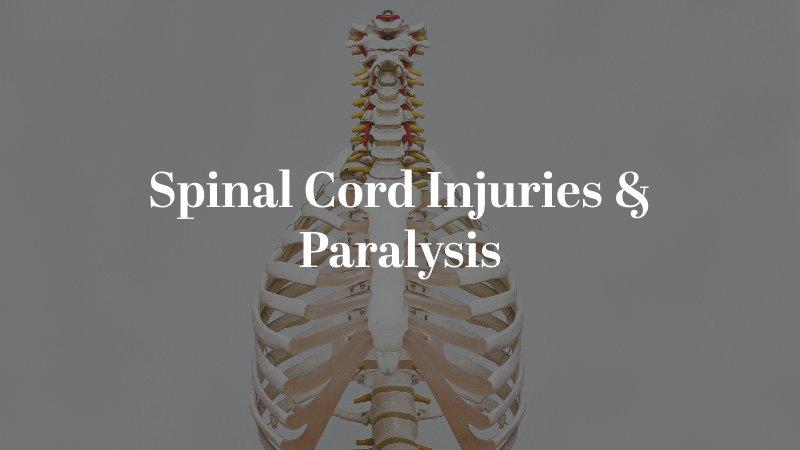According to the National Spinal Cord Injury Statistical Center or NSCISC, there are approximately 17,500 new cases of spinal cord injury each year in the United States. The top two causes of spinal cord injury are vehicle crashes and falls. Spinal cord injury is the second leading cause of paralysis in the U.S.
There are different types of spinal cord injury and categories of paralysis. These depend on the location and severity of a person’s spinal cord injury.
The following article outlines how spinal cord injuries can cause paralysis in victims of personal injury accidents such as car crashes, work injuries, and slips and falls. If you or your loved one need case-specific information or advice on filing a spinal cord injury claim, contact an experienced personal injury attorney.

What is a Spinal Cord Injury?
The Cleveland Clinic describes the spinal cord as a long, tube-like band of tissue that connects the brain to the lower back. The spinal cord’s job is to carry nerve signals back and forth between the brain and the body.
A spinal cord injury is caused by trauma to the spinal cord itself or to the tissue and bones that surround it. A spinal cord injury may be temporary or permanent and typically results in changes in sensation, movement, strength, and body functions below the injury site.
Spinal cord injuries may be incomplete or complete. In an incomplete spinal cord injury, the spinal cord can transmit messages to or from the brain.
In a complete spinal cord injury, all communications are lost below the injury site.
What is Paralysis?
Paralysis is the inability to make voluntary movements. A spinal cord injury can temporarily or permanently disrupt the nerve signals to body regions, prohibiting movement or sensation.
There are four main categories of paralysis depending on the body parts affected by a spinal cord injury.
Four Categories of Paralysis
The four categories of paralysis are monoplegia, hemiplegia, paraplegia, and quadriplegia.
Monoplegia
Monoplegia affects a single party of the body and may be temporary. It has many causes, including traumatic brain injury and prescription medication.
Hemiplegia
Hemiplegia affects one side of the body. It varies in severity and may be acquired or congenital.
The most common cause of hemiplegia is cerebral palsy.
Paraplegia
Paraplegia is paralysis below the waist. It is usually permanent and affects individuals differently. Paraplegia is commonly caused by a spinal cord injury.
Quadriplegia
Quadriplegia, or tetraplegia, is a loss of function from the neck down, although individuals may vary. The leading cause of quadriplegia is a spinal cord injury.
If you or your loved one suffers from any category of paralysis due to someone else’s reckless or negligent behavior, you may qualify for accident-related compensation. Call an experienced injury attorney in Denver for help today.
Contact an Experienced Spinal Cord Injury Attorney Today
Discuss your spinal cord injury with an experienced Denver spinal cord injury lawyer at Dulin McQuinn Young today. Our injury attorneys have a proven track record in the courtroom and are dedicated to holding wrongdoers accountable for their actions.
Dulin McQuinn Young has the resources and knowledge to give you the representation and attention you deserve. Schedule your complimentary consultation now.